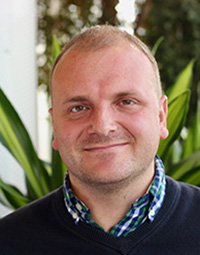
These human cells are engineered to turn from red to blue when they detect molecules associated with inflammatory disease. In the future, human cells could be engineered to deliver therapeutics when they detect inflammation, meaning a person with a disease like arthritis may never even know they have it. (Image provided by Michael Garton).
Michael Garton, an assistant professor at the Institute of Biomedical Engineering at the University of Toronto (U of T), is focused on designing tissues that are better than nature.
To accomplish this goal, Garton is leading a team funded by Medicine by Design’s Grand Questions Program.
“We have an amazing team of Toronto-based investigators and clinicians as well as international collaborators and advisors. We’re going into this with a holistic strategy, which will be grounded by our establishment of a new hub, the Centre for the Design of Novel Human Tissues. I think this will place Canada front-and-centre as a global leader in this area.”
The team’s vision is that one day someone who needed a heart transplant would receive new lab-made tissues within days, and the tissues would be engineered to survive ischemia, which is a lack of blood flow that kills tissue, a common problem in transplants.
But Garton, says that, while solving the ischemia problem is important, he also has bolder goals that could transform how a person experiences disease.

Michael Garton, assistant professor, Institute of Biomedical Engineering, University of Toronto. Photo by Jovana Drinjakovic.
“If we’re going to try and augment tissues to overcome transplantation challenges, why not add functions that make tissues behave in ways that deliver more therapeutic benefit? Could we have cells that release a natural drug when they sense a symptom coming on?”
Garton aims to accomplish this goal through the integration of synthetic biology into cells and tissues made from stem cells. His lab works with gene circuits, engineered systems that adapt natural functions to perform new, but unnatural, actions.
The Garton lab was launched in 2018 with support from Medicine by Design, As part of its commitment to attracting the finest emerging and established researchers in regenerative medicine from around the world to U of T and its affiliated hospitals, Medicine by Design has recruited Garton and 16 other researchers.
Back to “Five ways Medicine by Design is transforming treatment for cardiac disease.”






